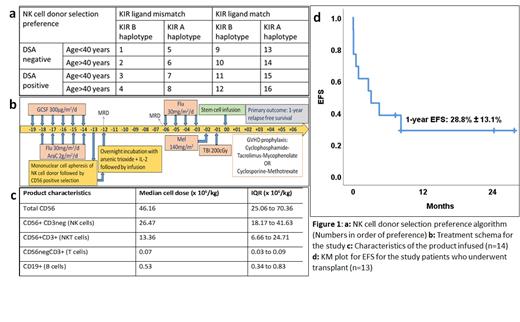Abstract
Refractory acute myeloid leukemia (AML), defined as failure of 2 cycles of induction therapy at diagnosis or of 1 cycle at relapse, represents a subgroup with poor clinical outcomes. In our transplant cohort, the 5-year overall survival in this subgroup was 16% (Ganapule at al. JGO 2017). Haploidentical natural killer cell (NK) therapy is a strategy that is being explored in refractory malignancies. Our in-vitro and animal model data suggest that exposure to arsenic trioxide (ATO) results in enhanced NK cytotoxicity (Alex AA et al. Front. Immunol 2018). Historically, at our center, patients with refractory AML have been treated with cytoreductive therapy (FLAG ± idarubicin or mitoxantrone + etoposide for 3 to 5 days) followed by 1-week rest and then a reduced-intensity transplant with fludarabine + melphalan conditioning while in peak cytopenia. From February 2019, we initiated a phase II single arm clinical trial (CTRI/2019/02/017505) enrolling patients with refractory AML planned for a stem cell transplant in peak cytopenia. Patients received CD56-positive cells from an HLA haploidentical related family donor (other than the stem cell donor, wherever feasible) following cytoreductive chemotherapy. The NK cell donor preference strategy included presence of KIR ligand mismatch, greater number of KIR B motifs (or the B score), lower donor age, and negative donor specific antibodies tested using flowcytometry crossmatch (Figure 1a). CD56-positive selection was done using CliniMACS prodigy system. This was followed by overnight incubation of the CD56 positive cells in autologous plasma with 2 micromolar ATO and 500 U/mL of interleukin-2. The CD56 positive cells were then infused to the patient 1-day after the completion of cytoreductive chemotherapy. This was followed by a reduced intensity stem cell transplant (Figure 1b). The primary outcome variable was 1-year relapse free survival. From February 2019, 14 patients with median age 28 years (IQR: 15.75-31.5) were enrolled in this trial. Six were females. Six had primary-refractory AML while 8 had relapsed-refractory AML. The cytoreductive chemotherapy was FLAG ± idarubicin (n=7), Mitoxantrone + Etoposide (n=6) and GCLAC (n=1). The median blast percentage on flowcytometry MRD testing prior to NK infusion was 15.9% (IQR: 9.1%-54.5%) (n=11). The median B score for the NK cell donors was 2 (IQR: 1-3). The median age of the NK cell donor was 43 years (IQR: 36-49.5). KIR ligand mismatch with the patient was noted in 2 donors. The median CD56-cell dose infused was 46.16 x 10 6/kg (IQR: 25.06-70.36) (Figure 1c). Pre-defined release criteria, including sterile cultures, and endotoxin negativity were met in all cases. There was no infusion related toxicity. The median blast percentage on flowcytometry MRD testing done following NK cell infusion was 11.9% (IQR: 4.9%-47.6%) (n=8). One patient withdrew consent after NK cell infusion and did not undergo transplant. For the remaining 13 patients, the stem cell donor was HLA matched (n=4), HLA 9/10 matched (n=1) or HLA haplomatched (n=8). The median CD34 cell dose infused was 10 x 10 6/kg (IQR:7.51-11.6). Five (38.5%) patients died of immediate post-transplant complications (sepsis (n=3) on days 1, 2 and 28, cerebral venous sinus thrombosis (n=1) on day 1 in a patient treated with hormonal contraceptives for menorrhagia, and veno-occlusive disease (n=1) on day 15 in a patient undergoing a second transplant) while 2 (15.4%) did not engraft (both subsequently died of infective complications following engraftment post-second transplant). Of the remaining 6 (46.2%) patients who engrafted and survived beyond 1 month of the transplant, the day 28 post-transplant MRD was negative for 5 patients while it was positive in 1 patient (0.13%). On follow up, 2 (15.4%) patients developed disease relapse (on days 54 and 218 respectively) and died. The remaining 4 (30.8%) patients are alive and relapse free at last follow up (mean follow up of surviving patients is 16 months). One patient received a CD34 cell boost on day 96 (cell dose - 8.55 x 10 6/kg) for poor graft function. For the entire cohort, the estimated 1-year event free survival is 28.8% ± 13.1%(Figure 1d). Whereas, acute GVHD was noted in 3 patients (50%; out of 6 evaluable patients) and chronic GVHD was noted in 3 patients (50%; out of the 6 evaluable patients). Thus, haploidentical NK cell therapy as an adjunct to transplant is safe and merits further evaluation in patients with AML.
Mathews: Christian Medical College: Patents & Royalties: US 2020/0345770 A1 - Pub.Date Nov.5, 2020; AML: Other: Co-Inventor.


This feature is available to Subscribers Only
Sign In or Create an Account Close Modal